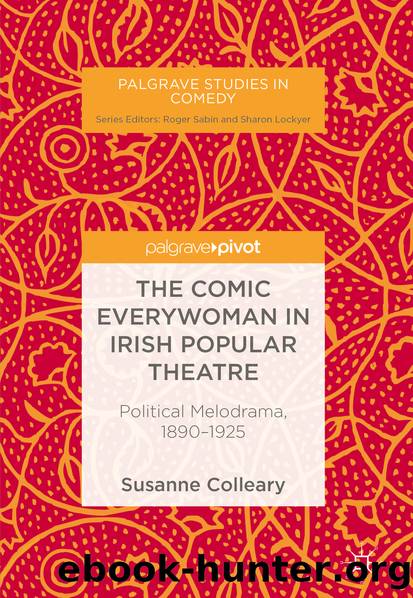The Comic Everywoman in Irish Popular Theatre by Susanne Colleary

Author:Susanne Colleary
Language: eng
Format: epub
ISBN: 9783030020088
Publisher: Springer International Publishing
Peacock again centralises the incongruous nature of the double act to slapstick as comic device, which can work appositionally or in accord when attacked by outside forces to create comic worlds of violence and pain. In similar vein, for Eric Weitz the audience enjoys the âsafely delivered brutalityâ of comic violence where âwe trust that no one really gets hurt and that even the victims are in on the joke.â26 Slapstick gags, according to Donald Crafton, can disrupt the cause and effect of narrative to act as âatemporal bursts of violence and or hedonism that are â¦. gratifyingâ for the audience.27 An audiencesâ enjoyment of comic violence is central; however, Peacock addresses intentional performed violence and pain on stage more specifically. She suggests that where intent is concerned, and this is not always the case, the question of morality necessarily becomes involved. Peacock makes the point that âbroadly put, if the pain appears deserved we are more likely to laugh than if it appears to be unjust.â28 Moral justice then, where audience perception recognises that the victim richly deserves comic punishment and pain, affects laughter as response. As to purpose, Peacock argues that âstatus plays a key role in whether or not we find slapstick funny ⦠as an audience, we find it funny to see the mighty fallen or to see dignity upset.â29 As has been seen through the plays, comic violence and pain are enacted through the action scenes that the servants (both in and out of the double) and others including the heroes (sometimes the heroines) become embroiled in. They inflict comic brutality on their enemies and in turn have violence perpetrated against them. The audience find enjoyment in vicariously living through the triumphs of the just and the deserved suffering of the corrupt. Here again is the victory of good over evil as central to the ethical world of political melodrama. That triumph is brought about temporarily through comic action scenes, where the servants are victorious in the aid of their betters, and where they know better than their âbettersâ in defeat of the enemy. Further, Peacockâs discussion of moral justice where the audience laugh at punishment ârichly deserved,â where the mighty have fallen, also speaks in very clear terms to how the violence and pain are operating the politics of nation for comic effect in the plays. In parallel, the politics of class work in a different way through comic violence, for implicitly or explicitly the servants upset hegemony on both sides of the divide for laughter. Finally, to my mind, Craftonâs point about slapstickâs capacity to disrupt the cause and effect of narrative is countered by the subtextual freedoms offered in playing out the comic potential in these scenes. There is plenty of room to co-create alternative or competing narratives with an audience through comic action, and this is something to which I will return in the next chapter.
Bergerâs satire, unhooked from the function of benevolence, is also in action through the works. Extending
Download
This site does not store any files on its server. We only index and link to content provided by other sites. Please contact the content providers to delete copyright contents if any and email us, we'll remove relevant links or contents immediately.
Call Me by Your Name by André Aciman(20351)
Ready Player One by Cline Ernest(14496)
How to Be a Bawse: A Guide to Conquering Life by Lilly Singh(7364)
Wiseguy by Nicholas Pileggi(5649)
The Kite Runner by Khaled Hosseini(5061)
On Writing A Memoir of the Craft by Stephen King(4847)
Audition by Ryu Murakami(4822)
The Crown by Robert Lacey(4710)
Call me by your name by Andre Aciman(4599)
Gerald's Game by Stephen King(4556)
Harry Potter and the Cursed Child: The Journey by Harry Potter Theatrical Productions(4428)
Dialogue by Robert McKee(4306)
The Perils of Being Moderately Famous by Soha Ali Khan(4156)
Dynamic Alignment Through Imagery by Eric Franklin(4100)
Apollo 8 by Jeffrey Kluger(3621)
Seriously... I'm Kidding by Ellen DeGeneres(3564)
The Inner Game of Tennis by W. Timothy Gallwey(3557)
How to be Champion: My Autobiography by Sarah Millican(3544)
Darker by E L James(3463)
